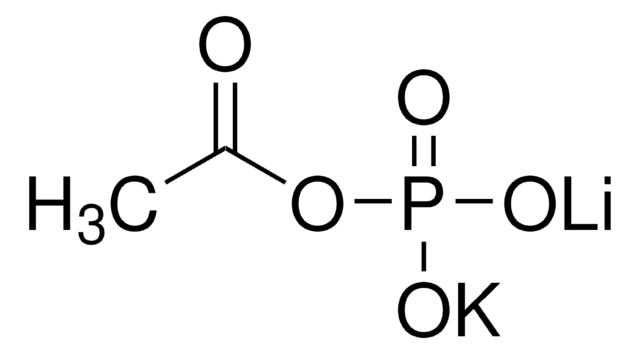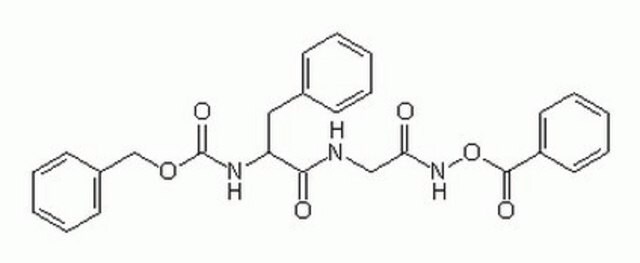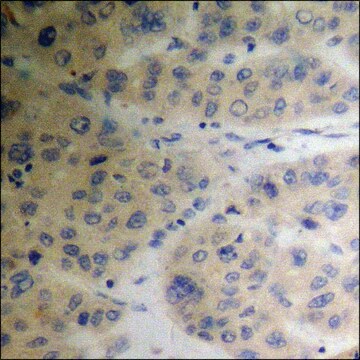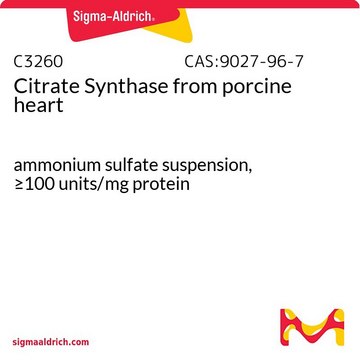P2783
Phosphotransacetylase from Bacillus stearothermophilus
lyophilized powder, ≥3,000 units/mg protein (biuret)
Synonym(s):
Acetyl-CoA:orthophosphate acetyltransferase, Phosphate acetyltransferase
Sign Into View Organizational & Contract Pricing
All Photos(1)
About This Item
Recommended Products
form
lyophilized powder
Quality Level
specific activity
≥3,000 units/mg protein (biuret)
composition
Protein, ≥20%
shipped in
wet ice
storage temp.
−20°C
Looking for similar products? Visit Product Comparison Guide
Application
Phosphotransacetylase, from Bacillus stearothermophilus, is used to convert CoA to acetyl CoA. Phosphotransacetylase (pta) is used to study transport systems for acetate. It is used to study metabolic pathways in various bacterium.
Biochem/physiol Actions
Phosphotransacetylase converts CoA to acetyl CoA.
Unit Definition
One unit will convert 1.0 μmole of CoA to acetyl CoA per min at pH 7.5 at 30 °C using acetyl phosphate as substrate.
Physical form
Lyophilized powder containing potassium phosphate
Signal Word
Warning
Hazard Statements
Precautionary Statements
Hazard Classifications
Eye Irrit. 2 - Skin Irrit. 2 - STOT SE 3
Target Organs
Respiratory system
Storage Class Code
11 - Combustible Solids
WGK
WGK 3
Personal Protective Equipment
dust mask type N95 (US), Eyeshields, Gloves
Choose from one of the most recent versions:
Already Own This Product?
Find documentation for the products that you have recently purchased in the Document Library.
G D Sprott et al.
Applied and environmental microbiology, 59(4), 1092-1098 (1993-04-01)
Eleven strains of methanogenic bacteria were divided into two groups on the basis of the directionality (oxidative or reductive) of their citric acid pathways. These pathways were readily identified for most methanogens from the patterns of carbon atom labeling in
Mutants of Bacillus stearothermophilus defective in the uptake and metabolism of acetate
Philip R. Mallinder and Anne Moir
Microbiology, 137, 779-785 (1991)
Jing Huang et al.
Wei sheng wu xue bao = Acta microbiologica Sinica, 51(4), 480-487 (2011-07-30)
To study the effects of gene pta disruption on biosynthesis of L-tryptophan. The pta gene of the L-tryptophan producing strain E. coli TRTH was disrupted by Red recombination technology and a pta mutant E. coli TRTHdeltapta was constructed. Fed-batch fermentation
Sara Castaño-Cerezo et al.
Microbial cell factories, 8, 54-54 (2009-10-27)
Acetate metabolism in Escherichia coli plays an important role in the control of the central metabolism and in bioprocess performance. The main problems related to the use of E. coli as cellular factory are i) the deficient utilization of carbon
Zoltán Gregus et al.
Toxicological sciences : an official journal of the Society of Toxicology, 110(2), 282-292 (2009-05-30)
Enzymes catalyzing the phosphorolytic cleavage of their substrates can reduce arsenate (AsV) to the more toxic arsenite (AsIII) via the arsenolytic substrate cleavage in presence of a reductant, as glutathione or dithiotreitol (DTT). We have shown this for purine nucleoside
Our team of scientists has experience in all areas of research including Life Science, Material Science, Chemical Synthesis, Chromatography, Analytical and many others.
Contact Technical Service








